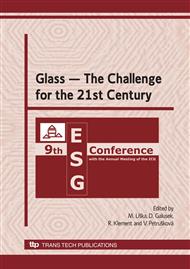p.269
p.273
p.279
p.287
p.293
p.299
p.305
p.311
p.317
Simulation of the Chemical Influences to the Polishing Process of Optical Glasses
Abstract:
In the last step of fabrication, optical and fine-optical glasses are polished to fulfill the optical requirements for their surfaces. The major influences on the process are caused by the mechanics of the polishing machine, by the chemistry (composition of the glass, as well as the polishing suspension of water and polishing grains, CeO2) [1], [2] and by the material and structure of the polishing pad. From previous own results [3], [4] it is known that the stability of the colloidal system has a major impact on the polishing results and that it is influenced by matter from the glass removal. Thus the glasses have been classified in glass families, depending on their chemical composition and their mutual compatibility in the process. As it is not always possible to measure this compatibility, the impact of the various dissolved glass ions in the fluid phase of the polishing suspension is simulated by the use of thermodynamic parameters. Therefore the specific solubility products in the aqueous phase are modeled (using, e.g., the software HSC) comprising steady accumulation of ions from the glass removal. With this simulation, the examination of the chemical part of the chemo-mechanical polishing process will be concluded.
Info:
Periodical:
Pages:
293-298
Citation:
Online since:
April 2008
Authors:
Price:
Сopyright:
© 2008 Trans Tech Publications Ltd. All Rights Reserved
Share:
Citation:


